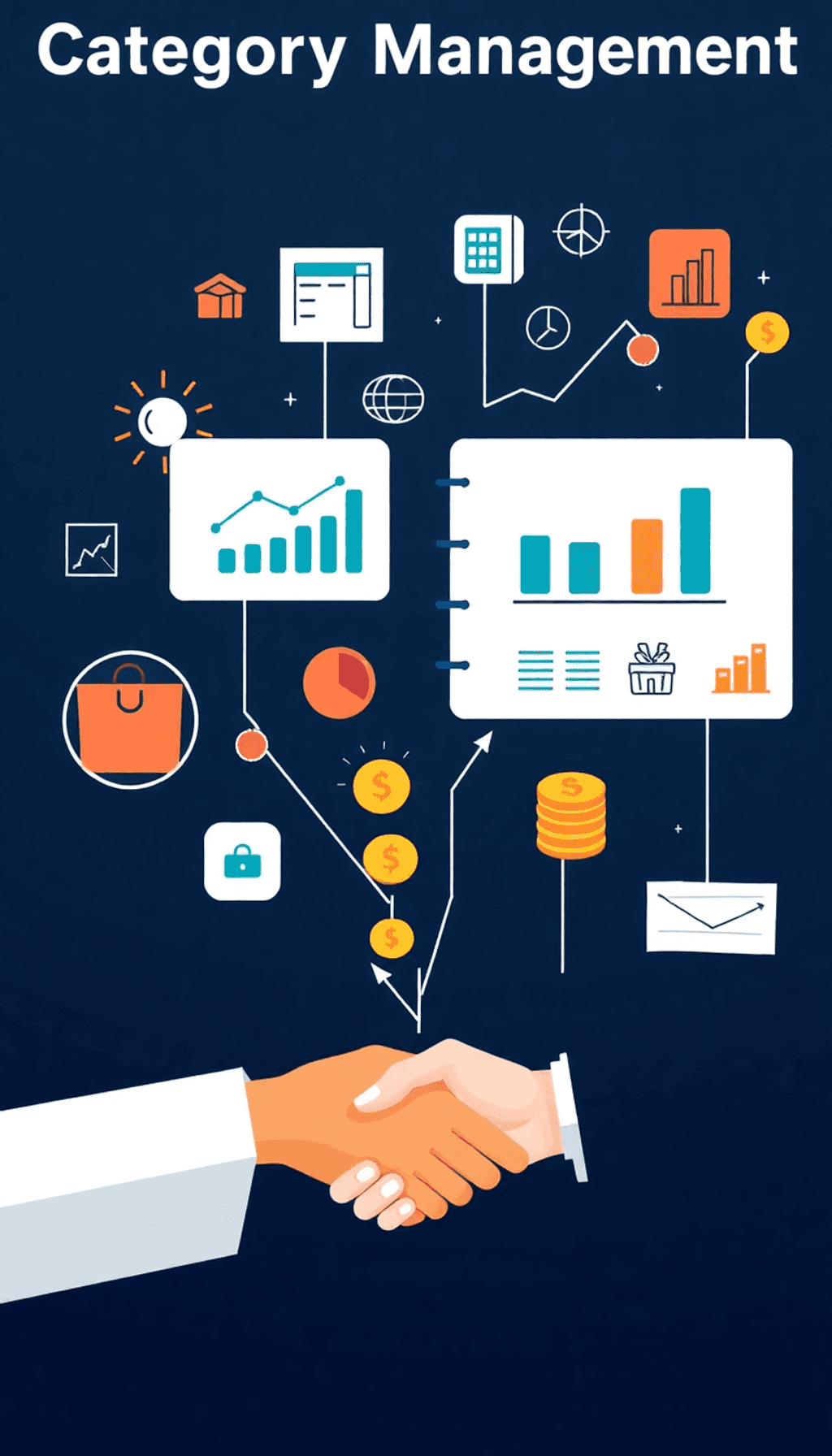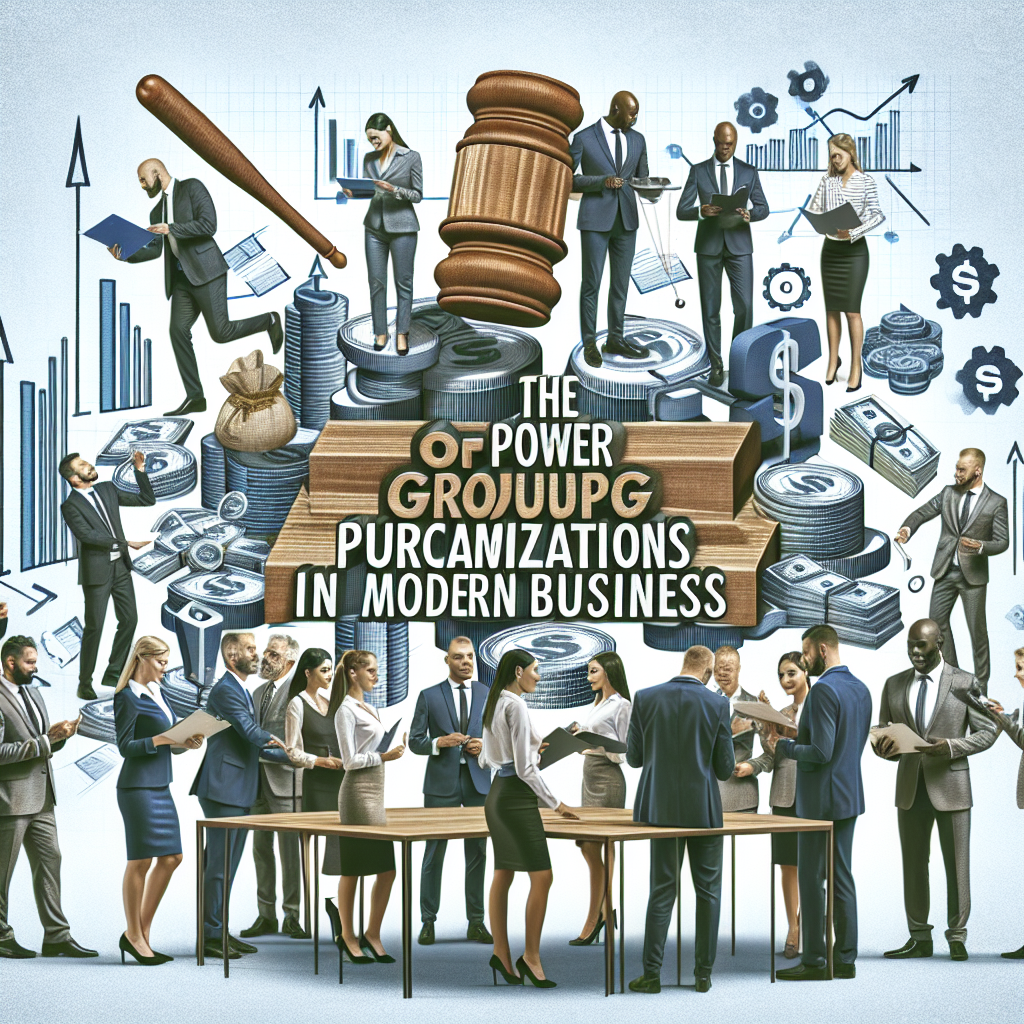Introduction
Category management in procurement is a strategic approach that organizes purchasing activities into specific categories. This methodology enhances procurement strategies by focusing on the unique needs and characteristics of each category, allowing for optimized spending and improved supplier relationships.
The importance of strategic procurement cannot be overstated. By implementing effective category management strategies, organizations can:
- Achieve significant cost savings
- Enhance supplier collaboration
- Improve market understanding
However, challenges do exist. Organizations may face difficulties in categorizing products, aligning supplier capabilities with their requirements, and ensuring ongoing monitoring and refinement of strategies.
This blog will explore critical aspects of category management in procurement, including:
- Understanding the concept and benefits of category management
- The role of strategic sourcing within category management
- Building strong supplier relationships for better outcomes
- Leveraging data analysis to inform decisions
- Establishing key performance indicators (KPIs) to measure success
- Identifying benefits, challenges, and best practices for implementation
- A case study featuring Hubzone Depot LLC as a model example
In addition to these topics, we will also delve into specific areas such as maximizing federal grant funding for nonprofits, boosting employee morale with break room supplies, and the importance of essential PPE for airborne precautions in healthcare.
Moreover, we’ll provide insights into discovering the best procurement software and outsourcing companies, highlighting how leading service providers can revolutionize your procurement strategy through our guide on best procurement software and outsourcing companies.
Engaging with these topics will provide valuable insights for organizations looking to enhance their procurement processes through effective category management.
Understanding Category Management
Category management in procurement refers to the strategic approach of organizing purchasing activities into specific groups or categories. This method optimizes procurement processes by allowing organizations to focus their efforts on understanding and managing distinct categories of products or services.
Key Benefits of Category Management
Organizing purchasing activities into categories offers several advantages:
- Improved Supplier Collaboration: By identifying and grouping similar products or services, organizations can foster stronger relationships with suppliers. This collaboration often leads to better pricing, service agreements, and innovation.
- Enhanced Market Understanding: Categorization allows procurement teams to gain deeper insights into market trends, supply risks, and demand fluctuations. This understanding enables more informed decision-making regarding sourcing strategies.
Methods for Categorizing Products and Services
Effective categorization relies on various methods, including:
- Supply/Demand Drivers: Analyzing factors that influence the supply and demand for specific products helps in segmenting them effectively. For instance, a high-demand category may necessitate different supplier engagement strategies compared to a stable or declining one.
- Market Dynamics: Understanding market conditions is crucial for effective category management. Factors such as competition levels, regulatory environments, and technological advancements must be considered when categorizing products or services.
- Cost Structure Analysis: Evaluating the cost components associated with different categories aids in identifying opportunities for savings and efficiency improvements.
By implementing these categorization methods, organizations can streamline their procurement processes, ultimately leading to enhanced efficiency and better alignment with business objectives. The strategic organization of purchases not only simplifies management but also prepares businesses to adapt quickly to changing market conditions.
For those looking to enter this field, there are numerous entry-level procurement jobs available that can help kickstart a career in supply chain management. However, it’s essential to understand the nuances of the industry, including certain procurement terms to avoid for effective communication about the value of procurement.
Moreover, as we look towards the future, it’s important for professionals in this space to stay informed about salary trends such as those in the procurement engineer salary sector which are projected to evolve by 2025. Additionally, understanding concepts like Diversity, Equity, and Inclusion (DEI) is becoming increasingly important in today’s workplace environment. Lastly, while considering purchasing strategies like Group Purchasing Organizations (GPOs), it’s vital to debunk some common myths associated with them through proper mythbusting GPOs.
Strategic Sourcing: A Key Component of Category Management
Strategic sourcing plays a vital role in the effectiveness of category management efforts. It goes beyond traditional purchasing, emphasizing a comprehensive approach to supplier selection and relationship management. By adopting strategic sourcing practices, organizations can enhance their procurement processes significantly.
Importance of Strategic Sourcing
- Proactive Supplier Selection: Identifying and engaging suppliers who align with organizational goals is crucial. This proactive approach ensures that you are not only securing the best prices but also forming partnerships that yield long-term benefits. For instance, implementing effective sourcing strategies for hiring top talent can serve as a model for supplier selection.
- Total Cost of Ownership (TCO): Evaluating suppliers based on TCO rather than just initial pricing allows for a more accurate assessment of overall value. Considerations such as quality, reliability, and service levels must be included in this evaluation.
Criteria for Selecting Suppliers
When selecting suppliers within each category, consider criteria beyond price:
- Quality Assurance: Assess the quality standards of potential suppliers to ensure they meet your organization’s requirements.
- Capacity and Reliability: Evaluate the ability of suppliers to deliver consistently without delays or shortages.
- Innovation Capabilities: Look for suppliers who can provide innovative solutions or improvements that may enhance your procurement strategy. Keeping an eye on top trends in supplier innovation can be beneficial here.
Sourcing Strategies Based on Category Characteristics
Different categories often necessitate unique sourcing strategies. Some approaches include:
- Competitive Bidding: Useful for categories where multiple suppliers exist and cost competitiveness is essential.
- Long-Term Partnerships: Ideal for critical categories where collaboration with fewer suppliers can lead to enhanced value through shared knowledge and innovation.
- Sustainable Sourcing: For organizations focusing on environmental responsibility, prioritizing suppliers committed to sustainable practices can align procurement strategies with corporate social responsibility goals.
Moreover, it’s essential to understand the differences between strategic sourcing and category management, as this knowledge can further refine your approach.
By integrating these aspects into your category management framework, you maximize not only procurement efficiency but also foster stronger relationships with suppliers, ultimately leading to better business outcomes. If you have any questions or need further assistance regarding these strategies, feel free to reach out through our contact page.
Building Strong Supplier Relationships through Effective Category Management
Supplier partnerships play a critical role in achieving successful category outcomes. When organizations invest in robust supplier relationship management, they unlock several key advantages that enhance procurement strategies.
Importance of Supplier Relationship Management
- Driving Success: Strong relationships with suppliers lead to better communication, quicker problem resolution, and increased innovation. Organizations that prioritize these connections often experience improved service levels and quality of products.
- Risk Mitigation: Collaborative relationships can help identify potential risks early on, allowing for timely interventions. Trust between parties reduces the likelihood of supply chain disruptions.
Approaches to Fostering Collaboration
To cultivate effective collaboration with suppliers within each category, consider these strategies:
- Regular Communication: Establish routine check-ins to discuss performance metrics and address any concerns. Transparency is essential for nurturing trust and reliability.
- Joint Business Planning: Collaborate on strategic initiatives that align with both parties’ goals. This ensures that all stakeholders are working toward common objectives.
- Feedback Mechanisms: Create structured feedback processes to gather insights from suppliers about your organizational needs, leading to continuous improvement.
Aligning Supplier Capabilities with Organizational Needs
Achieving mutual benefit requires alignment between supplier capabilities and organizational requirements. Focus on the following aspects:
- Understanding Needs: Clearly articulate your organization’s needs and expectations. This clarity helps suppliers tailor their offerings accordingly.
- Evaluating Compatibility: Assess supplier strengths against your operational needs before forming partnerships. A well-suited supplier can provide significant value by addressing specific challenges.
- Performance Metrics: Develop KPIs that reflect both parties’ contributions to success. Regularly review these metrics to ensure alignment remains intact.
In times of uncertainty, it’s crucial to adopt strategies like tail spend management and building resilience in procurement which not only enhance procurement efficiency but also foster a collaborative environment where both parties thrive together. Furthermore, implementing measures to maximize supplier performance can significantly improve the quality and reliability of the products received from suppliers.
Leveraging Data Analysis for Informed Decision-Making in Category Management
Data analysis plays a critical role in category management, enabling businesses to identify opportunities and mitigate risks across various product and service categories. Understanding consumer behavior through analytical insights is essential for informed decision-making.
Significance of Data Analysis
1. Identifying Opportunities
By analyzing historical purchasing patterns, organizations can pinpoint high-demand products and services. This knowledge allows you to tailor your procurement strategies effectively.
2. Mitigating Risks
Analyzing market trends helps in recognizing potential risks, such as price volatility or supply chain disruptions. Proactive measures can be taken to source alternatives or negotiate better terms with suppliers.
Utilizing Market Insights
Market insights derived from data analysis inform sourcing initiatives and pricing strategies. Engaging in consumer behavior analysis provides a deeper understanding of what drives purchasing decisions. This information can significantly impact negotiations and supplier selections.
1. Market Trends
Staying updated on market trends allows organizations to adjust their strategies according to changing demands, ensuring they remain competitive.
2. Competitive Landscape
Knowing where competitors stand regarding pricing and offerings helps you make strategic decisions that enhance your organization’s positioning.
Practical Applications
Incorporate the following methods into your category management practices:
-
Data-Driven Sourcing Initiatives:
- Use analytics tools to track supplier performance and pricing history.
- Identify underperforming categories that require strategic intervention.
-
Pricing Strategy Development:
- Analyze market data to align prices with current consumer expectations.
- Leverage insights on competitor pricing to create competitive offers without sacrificing margins.
Utilizing data analysis not only enhances procurement efficiency but also fosters a responsive approach to market dynamics. By embracing these analytical strategies, organizations can optimize their category management efforts, ultimately driving better business outcomes while remaining adaptable to shifts in the marketplace.
Measuring Success: Key Performance Indicators (KPIs) in Category Management
Establishing relevant Key Performance Indicators (KPIs) is crucial for assessing the impact of category management strategies on overall business performance. KPIs serve as measurable values that demonstrate how effectively an organization is achieving key business objectives. In the context of category management, these indicators can take various forms, such as:
- Cost Savings: Tracking reductions in procurement expenses across different product categories.
- Supplier Performance: Evaluating supplier reliability, lead times, and quality metrics to ensure alignment with organizational goals.
- Compliance Rates: Monitoring adherence to established procurement policies and procedures within each category.
- Market Share Growth: Analyzing increases in market presence linked to effective category management strategies.
Ongoing monitoring of these KPIs plays a significant role in driving continuous improvement. Regular assessment allows organizations to identify areas for enhancement and adapt their strategies accordingly. This approach fosters an environment where:
- Data-Driven Decisions: Insights drawn from KPI tracking inform sourcing initiatives and identify potential risks.
- Feedback Loops: Continuous evaluation creates opportunities for feedback that can be used to refine procurement practices.
- Agility in Strategy: Organizations can pivot their approaches based on real-time data, ensuring responsiveness to market dynamics.
Incorporating a structured framework for KPI tracking enhances effectiveness in category management. For instance, adopting a systematic review process at regular intervals enables teams to evaluate performance against established benchmarks. This proactive stance not only ensures that teams remain aligned with strategic objectives but also facilitates informed discussions around necessary adjustments.
Ultimately, the integration of relevant KPIs and the commitment to ongoing refinement will empower organizations to optimize their category management efforts effectively. A key aspect of this optimization involves embracing a mindset of continuous learning and adaptation in procurement practices, similar to the transformative journey experienced by Frank Corris, which has been instrumental in mastering procurement through strategic thinking and learning.
Benefits, Challenges, and Best Practices for Implementing Category Management Strategies
Implementing effective category management strategies can lead to significant cost savings through optimized procurement processes. Some key benefits include:
1. Enhanced Efficiency
Streamlining purchasing activities reduces time and resource expenditure, allowing teams to focus on strategic initiatives.
2. Improved Supplier Negotiations
By grouping similar purchases, organizations can leverage their buying power to negotiate better terms and pricing. This is where understanding the difference between purchasing groups and group purchasing organizations becomes crucial.
3. Greater Market Insight
Categorizing products allows teams to understand market dynamics better, leading to informed decision-making.
Despite these advantages, organizations often encounter challenges during implementation:
1. Resistance to Change
Employees may be hesitant to adopt new processes. To address this, involve stakeholders early in the process and provide training on new tools and methodologies.
2. Data Management Issues
Poor data quality can hinder effective category management. Establish a robust data governance framework that ensures accurate and timely information is available for decision-making.
3. Limited Supplier Engagement
Organizations may struggle with building strong supplier relationships. Developing a structured communication plan that fosters collaboration is essential for long-term success.
Best Practices for overcoming these challenges include:
- Conduct Regular Training Sessions: Equip your team with the necessary skills and knowledge related to category management practices.
- Utilize Technology Solutions: Implement procurement software that aids in data analysis and supplier collaboration, streamlining the overall process.
- Focus on Continuous Improvement: Regularly assess your category management strategies against established KPIs to identify areas for enhancement.
Addressing these common challenges while leveraging the benefits of category management in procurement positions organizations for sustained success. Additionally, organizations can unlock exclusive membership benefits that further enhance their category management strategies.
Case Study: Hubzone Depot LLC as a Model Example
Hubzone Depot LLC exemplifies effective category management through its strategic approach. As a HUBZone certified woman-owned supplier, the company has successfully optimized procurement processes while ensuring compliance with HUBZone regulations. Key elements of their strategy include:
- Categorization of Products: By organizing products into distinct categories such as office supplies, MRO, and safety equipment, Hubzone Depot enhances supplier collaboration and market understanding.
- Cost Reduction Achievements: Clients have reported an average cost reduction of over 20%, with specific categories yielding savings between 10-35%. This illustrates the tangible benefits of their procurement strategy, particularly the power of leveraging drastic cost reduction through collective spend.
- Focus on Relationships: The company prioritizes building strong relationships with suppliers, fostering a collaborative environment that drives mutual benefits.
Lessons learned from Hubzone Depot’s success can be applied to other organizations:
- Implement tailored category management practices to align purchasing strategies with organizational goals.
- Leverage data insights to identify opportunities for cost savings and improved supplier performance.
- Maintain ongoing communication and collaboration with suppliers to ensure alignment with market dynamics.
These strategies position Hubzone Depot as a model for organizations aiming to enhance their procurement processes while achieving significant savings. For those managing a one-person procurement function, Hubzone Depot’s strategic solutions can provide valuable insights into cost efficiency and supplier management. The lessons from their experience in [procurement optimization](https://hubzonedepot.com/tag/procurement-optimization) are applicable across various sectors.
Conclusion
Implementing category management in procurement allows organizations to adapt to ever-changing market demands. By optimizing resources effectively through strategic procurement practices, businesses can enjoy several advantages:
- Cost Reduction: Streamlined processes lead to significant savings.
- Supplier Collaboration: Strengthened relationships enhance product quality and service delivery, underscoring the importance of transparent supplier communication.
- Market Insights: Improved understanding of market dynamics fosters informed decision-making.
Organizations that embrace category management have the potential to drive sustainable business growth. The experiences of Hubzone Depot LLC serve as a valuable example, showcasing the real benefits that come from implementing effective category management strategies. By prioritizing the optimization of procurement activities and building strong partnerships with suppliers, companies can overcome obstacles and seize opportunities in today’s competitive landscape.
For instance, succeeding with limited resources is possible by embracing constraints, optimizing processes, and leveraging networks for business success. Adopting these practices not only enhances operational efficiency but also positions organizations for long-term success in their specific markets.
FAQs (Frequently Asked Questions)
What is category management in procurement?
Category management in procurement refers to the strategic approach of organizing purchasing activities by grouping similar products or services into categories. This method aims to optimize procurement processes, enhance supplier relationships, and improve overall efficiency.
What are the key benefits of implementing effective category management strategies?
The key benefits of effective category management include improved supplier collaboration, enhanced market understanding, cost savings through optimized procurement processes, and the ability to adapt to changing market demands.
How does strategic sourcing relate to category management?
Strategic sourcing is a critical component of category management that involves proactively selecting suppliers based on various criteria beyond just price. It focuses on total cost of ownership and employs diverse sourcing strategies tailored to specific category characteristics.
What role does data analysis play in category management?
Data analysis is significant in category management as it helps identify opportunities and mitigate risks within different product or service categories. By utilizing market insights, organizations can inform their sourcing initiatives and pricing strategies effectively.
How can organizations measure the success of their category management strategies?
Organizations can measure the success of their category management strategies through the establishment of relevant Key Performance Indicators (KPIs). Ongoing monitoring and refinement of these KPIs are crucial for assessing impact and driving continuous improvement.
What challenges might organizations face when implementing category management, and how can they overcome them?
Common challenges include resistance to change, lack of data, and insufficient supplier engagement. Organizations can overcome these obstacles by fostering a culture of collaboration, investing in data analytics tools, and developing strong partnerships with suppliers.





